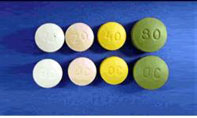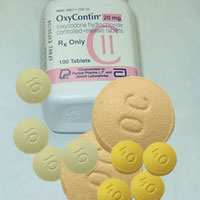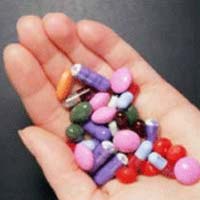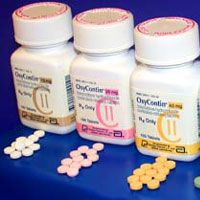- About Us
- Columns
- Letters
- Cartoons
- The Udder Limits
- Archives
- Ezy Reading Archive
- 2024 Cud Archives
- 2023 Cud Archives
- 2022 Cud Archives
- 2021 Cud Archives
- 2020 Cud Archives
- 2015-2019
- 2010-2014
- 2004-2009
 |
A Timely Revisit From The Cud Archives- |
This past month, drug manufacturer Purdue Pharma LP announced that it was cutting the remainder of its sales force amid countless ongoing lawsuits filed by some twenty two U.S states. Back in 2007 the company pleaded guilty to misleading the public about the risk of addiction associated with their opiate drug Oxycontin and paid a settlement of US$600 million, but it is argued that since that decision Purdue Pharma continued to engage in deceptive marketing practices encouraging continued sale and use of the drug.
With this news at hand, we thought this issue to revisit one of the most popular articles ever published in the pages of The Cud- from 2005 addressing both the Oxycontin drug epidemic in America, and the role that the now-embattled company played in actively contributing to the nation's growing addiction crisis.
Perhaps one of the most devastating drug epidemics gripping America in recent years has been abuse of the prescription drug Oxycontin, manufactured by the Conneticut-based company Purdue Pharmaceuticals L.P ('Purdue Pharma').
Derived from opium, and containing the active ingredient of what is known as 'oxycodone', Oxycontin was, and indeed still is, hailed as something of a 'miracle drug' for those whom it was originally intended for, that being primarily terminal cancer patients and chronic pain sufferers. Taken as a tablet, the drug is designed for slow release over a twelve hour period, so that a patient is only required to take two doses a day, offering relief and a high similar to morphine. Given the strength of the medication, however, a full 100% of all users become physically dependent, and it has been estimated in some quarters that addiction rates to the drug run as high as 30%.
 Controversially, many argue that Purdue Pharma over-marketed the product upon its release in 1995. When over-prescription of the drug by doctors combined with word of Oxycontin's powerful effects, demand on the streets began to grow at a rapid pace. So as to avoid the controlled-release mechanism of the pill, chewing, crushing, snorting or, dissolving in water and then injecting the drug was found to offer a concentrated high comparable to top grade heroin but with the FDA approved reliability of coming in a pure, same-size dose every time. Legal, covered by most health insurance plans, with patients of both legitimate and phoney claims receiving prescriptions for the pill, and many packets of the drug stolen from medical practices and family medicine cabinets alike, a drug problem soon emerged across social and economic classes in America unlike anything that had been seen before. From rural areas to the suburbs, offices to high schools, Oxycontin had taken grip. Indeed, regardless of whatever mark up dealers put on the drug at the street level, in 2002 7 million prescriptions had been written for Oxycontin, generating sales for Purdue of a truly staggering $1.5 billion.
Controversially, many argue that Purdue Pharma over-marketed the product upon its release in 1995. When over-prescription of the drug by doctors combined with word of Oxycontin's powerful effects, demand on the streets began to grow at a rapid pace. So as to avoid the controlled-release mechanism of the pill, chewing, crushing, snorting or, dissolving in water and then injecting the drug was found to offer a concentrated high comparable to top grade heroin but with the FDA approved reliability of coming in a pure, same-size dose every time. Legal, covered by most health insurance plans, with patients of both legitimate and phoney claims receiving prescriptions for the pill, and many packets of the drug stolen from medical practices and family medicine cabinets alike, a drug problem soon emerged across social and economic classes in America unlike anything that had been seen before. From rural areas to the suburbs, offices to high schools, Oxycontin had taken grip. Indeed, regardless of whatever mark up dealers put on the drug at the street level, in 2002 7 million prescriptions had been written for Oxycontin, generating sales for Purdue of a truly staggering $1.5 billion.
And so it is that today in many parts of the country Oxycontin has become 'the new Valium' for homemakers in suburbia, and there's been a proliferation of so-called 'pill parties' among teenagers where participants meet to try a variety of prescription drugs including Oxycontin. Naturally, taking the medication in combination with other drugs and alcohol (also known as 'polypharmacy') and broken down into a concentrated form is incredibly dangerous, and perhaps far more dangerous than these unsuspecting teenagers might realise. One 80mg dose of Oxycontin, for instance, is the equivalent of taking 16 pills of the well'known painkiller Percocet (also a target for drug abusers). Given this kind of potency, overdose from Oxycontin can occur easily. Though it can take many forms, the most common result is a state of respiratory depression leading to potential complete respiratory failure. To date, while the official figures vary widely, several hundred deaths related to Oxycontin use have been confirmed, although some circles argue that the true extent of overdoses is impossible to calculate because so many deaths, particularly among those from the white middle'class sector of users have been spared 'official victim' status so as to remove the potential stigma of being labelled an Oxycontin abuser.
 Indeed, that the drug has afflicted such a socio-economic class is one of the main reasons that it is an epidemic so often unheard of outside certain circles and in the mainstream media. Perhaps the most significant scandal involving Oxycontin to hit the headlines was the 2003 discovery that right wing talkshow host Rush Limbaugh was addicted to Oxycontin and may well have acquired the drug on the illegal black market. This was after Limbaugh had angrily asserted on a number of occasions on his nationally-syndicated radio show that drug users deserved harsh prison penalties over expensive treatment programmes. In 1995 he declared:
Indeed, that the drug has afflicted such a socio-economic class is one of the main reasons that it is an epidemic so often unheard of outside certain circles and in the mainstream media. Perhaps the most significant scandal involving Oxycontin to hit the headlines was the 2003 discovery that right wing talkshow host Rush Limbaugh was addicted to Oxycontin and may well have acquired the drug on the illegal black market. This was after Limbaugh had angrily asserted on a number of occasions on his nationally-syndicated radio show that drug users deserved harsh prison penalties over expensive treatment programmes. In 1995 he declared:
'There's nothing good about drug use... Drug use destroys societies... And we have laws against selling drugs, pushing drugs, using drugs, importing drugs. And the laws are good because we know what happens to people in societies and neighborhoods which become consumed by them. And so if people are violating the law by doing drugs, they ought to be accused and they ought to be convicted and they ought to be sent up.'
He concluded by adding:
'What this says to me is that too many whites are getting away with drug use... The answer is to go out and find the ones who are getting away with it, convict them and send them up the river (to prison) too.'
Hypocritically, Limbaugh was of course not, as per his own harsh assessment of the drug use problem in America, convicted, and still hosts his radio show despite the fact it was alleged his housekeeper acted as his drug buyer for years prior to his addiction becoming public.
And yet it is arguably this kind of soft treatment of Oxycontin that has allowed the issue to linger relatively unabated for years. Responding to pressure and a number of lawsuits, Purdue Pharma embarked upon a public service announcement campaign in 2003 saying that 4 million Americans were abusing or misusing prescription drugs each month, and also reported that it was working toward developing a so-called 'smart pill' which loses its painkilling properties if crushed and snorted, however such technology is years away, and at present, with those billions of dollars of profit at stake, Oxycontin is still available to be prescribed, stolen, dealt and misused by Purdue Pharma regardless.
On the other side of the debate, of course, are the thousands of very real victims of terminal cancer and chronic pain who look to Oxycontin for relief every day, and depend upon the pill to sustain the quality of their lives.  They are, quite understandably, staunch opponents of any move that might outright ban the availability of the drug, and yet there isn't a happy balance to be found in a situation where 'any availability' equates to 'any available drugs might be abused'. Complicating the matter further have been reputed allegations of journalists, politicians and medical practitioners receiving financial and other incentives from Purdue Pharma.
They are, quite understandably, staunch opponents of any move that might outright ban the availability of the drug, and yet there isn't a happy balance to be found in a situation where 'any availability' equates to 'any available drugs might be abused'. Complicating the matter further have been reputed allegations of journalists, politicians and medical practitioners receiving financial and other incentives from Purdue Pharma.
While it would be unfair to accuse Oxycontin solely of all of the recorded deaths related to the drug where victims have been engaged in polypharmacy, many lobby groups arguing in defence of the drug may have financial interests at stake as well. Indeed, for all the beneficial and long'overdue public service announcements, community awareness campaigns and community grants initiated by Purdue Pharma in recent years, it is well worth recognising the significant disparity which no doubt exists between the cost of such initiatives and the company's overall annual profit results.
And so the epidemic continues. Many rural and smaller communities across America such as Maine and Virginia that had been unfamiliar with regular occurrences of crime have recently seen Oxycontin'attributed incidents triple in number.  In areas like Massachusetts, efforts to curb the availability of the drug have pushed pill prices as high as $80 and $90 each, pushing many addicts -several teenagers among them- to find more affordable hits in equally dangerous and addictive $4 or $5 bags of heroin. The answer to abating the problem no doubt lies in encouraging further education and awareness of the risks of Oxycontin abuse, however resolving the issue of availability when so many ill Americans genuinely depend upon the drug is an altogether more complicated matter whose resolution, with extended delay, is only serving to broaden the potential number of victims affected.
In areas like Massachusetts, efforts to curb the availability of the drug have pushed pill prices as high as $80 and $90 each, pushing many addicts -several teenagers among them- to find more affordable hits in equally dangerous and addictive $4 or $5 bags of heroin. The answer to abating the problem no doubt lies in encouraging further education and awareness of the risks of Oxycontin abuse, however resolving the issue of availability when so many ill Americans genuinely depend upon the drug is an altogether more complicated matter whose resolution, with extended delay, is only serving to broaden the potential number of victims affected.
